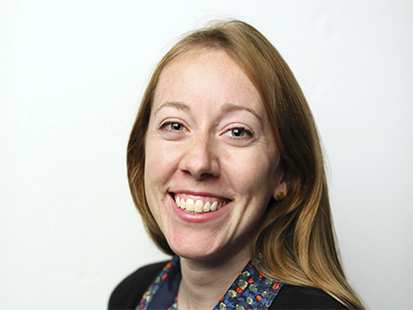
Kerri MacDonald | Photo credit: Sara Krulwich/The New York Times
What is a social media photo editor?

This Q&A has been edited for space and clarity.
Kerri MacDonald is the social media photo editor for The New York Times. She was serving as a photo editor at The Times when her current position was created in January 2015.
MacDonald says Times leadership created the position because they wanted to make sure someone was focusing full time on “highlighting the best of our photography across platforms.”
In addition to Lens, its photo blog, Times photography is showcased on the following platforms:
MacDonald says staff has also experimented with Facebook Live to talk about photography and share photo slideshows.
What do you do as a social media photo editor?
My primary goal is to enhance the presence and presentation of our photography on social platforms. I manage @nytimes, our primary Instagram feed, and I help oversee our overall Instagram presence, working closely with Jessica Anderson, a social strategy editor. As a member of the social team, I contribute to our Facebook and Twitter feeds. I work with photo editors to get a sense of upcoming stories so that we can find ways to present those stories on social media. I work with our photographers and journalists across the newsroom who are using social platforms to share photos. And I coordinate with desks working on user-generated photo projects or seeking news photos from social media.
What does a typical day look like for you?
We start posting on Instagram shortly after I wake up and finish shortly before I fall asleep. So I look at my phone for much of the day, monitoring our posts and following the conversation in the comments. I do a bit of work from home most mornings before heading into the office.
Every day I attend a meeting with photo editors at noon. The Page One photo editor’s goal is to find strong imagery that may land on the front page of the print paper as well as on the homepage, but I’m there to keep track of stories big and small. A story doesn’t have to appear on the front page to make waves on social media.
I spend a lot of my time digging through all of our photo shoots to find images that work for social. My goal is to find outtakes from stories, but sometimes a Page One image is a Page One image for a reason: It needs to be seen.
Throughout the day, I write captions and interact with the Instagram audience. I monitor the news and our stories and post photos on Facebook and Twitter. I also work with photographers on upcoming projects and on “weekend projects” we run on @nytimes, which vary in theme. And when the social landscape changes somewhat, I spend time brainstorming ways we can adapt. The latest challenge: Instagram Stories.
Are you the only social media photo editor at The New York Times?
I am the only social media photo editor, but many of my colleagues work at the intersection of these two worlds. A few photo editors work on our subject-oriented accounts on Instagram, and photo editors across the newsroom think about social media as they prepare big enterprise or breaking news stories. At the same time, social media editors are looking for strong photography to share. And colleagues of mine across the newsroom have worked with user-generated photos from social media. Many of our sections do photo-oriented “callouts,” asking for readers to share photos on a particular subject. We have an extraordinary tool to help us collect, obtain rights for and display photos from Instagram users. We used it with our travel section’s annual “52 Places to Go” feature and for a callout about the first day of summer.
Why does social media need its own photo editor?
Because there’s so much opportunity. The Times has a team of staff photographers and countless freelance photographers working all over the world, filing photos every single day. Visual material is so important on social networks, and there’s a huge network of both amateur and professional photographers who are particularly eager to see more of our work. There are so many ways to tell stories today, but one strong image can be an incredibly effective tool.
My job was created to ensure we’re sharing as much of this work across our major platforms, doing so in a way that maximizes the photography, and thinking about where we can go beyond sharing a photo on Facebook. Sometimes it’s simple and other times a lot of work goes into a presentation for social. A recent example: our story about the
Canadians who are essentially adopting Syrian refugee families. Damon Winter, a staff photographer, shot portraits for the story, and we prepared different presentations for the online presentation, the newspaper, Instagram, Facebook and Twitter. The reporters jumped in to add a few little details to captions for Instagram, to really make each one an individual story.
What does success look like for a social media photo editor?
We look at engagement on every photo we share. I have a sense of what will do well and some subjects are a given: beautiful travel photos, colorful food images, animal photos. But there are surprises. A great photographer can make an outstanding photo at a press conference — we see this on the campaign trail, for instance. I feel like I’ve really done my job when a photo that is more serious in nature touches people. We won a Pulitzer this year for our coverage of the refugee crisis by four photographers. Most of their photos, which we shared over time, caught people’s attention on social.
How many pictures are you dealing with in a day’s time?
I’ve never counted, but I know that it depends on the day. New York Times editors working on Page One, a big breaking news story, or the homepage may look at thousands of images every day. During an event like the Olympics, I have my eyes glued on more photos than usual. Right now I am primarily looking at work shot by our photographers, staff and freelancers. I’m sure that I look at hundreds of photos daily, and sometimes thousands.
Does your team ever shoot separate photos for social media platforms? If so, what makes them stand apart, if anything, from the photos you might shoot for your website or print product?
For the most part, we share images and outtake images from New York Times stories, and we run them square on Instagram. But we do shoot for social media on occasion. Street photographers shoot for @nytimesfashion during large fashion events. The day before the Rio opening ceremony, I asked Doug Mills, a staff photographer who is covering the Olympics, to shoot our first-ever Instagram Story for @nytimes.
George Etheredge, one of our summer photography interns, ran all over New York to document the first day of summer for Instagram. And Andrea Mohin, a staff photographer who focuses primarily on dance, is working on an Instagram project this summer about dancing outdoors.
I don’t usually ask people to shoot a different type of photo for social, but I love working with photographers who are strong reporters: they gather names, ages, backgrounds. They talk to the people they’re photographing to learn more. Little details can be particularly valuable in an Instagram caption. The name of an iguana. The type of mini-car two little girls are driving. Intimate details can make good social media photos better. Intimate photos, too. But as I said earlier, a great photo is a great photo regardless of the platform.
What’s the best way you’ve been able to interact or engage with your audience using photos on social media?
We’ve hosted two in-person events, “Instameets,” because what better way to interact than to meet your audience face-to-face? But there are other ways we engage with readers: asking people to share their photos of the first day of summer, or asking questions in our captions. I regularly talk to our followers in the comments section on @nytimes. And I love to see photographers jumping into the comments to answer questions from followers.

Comments